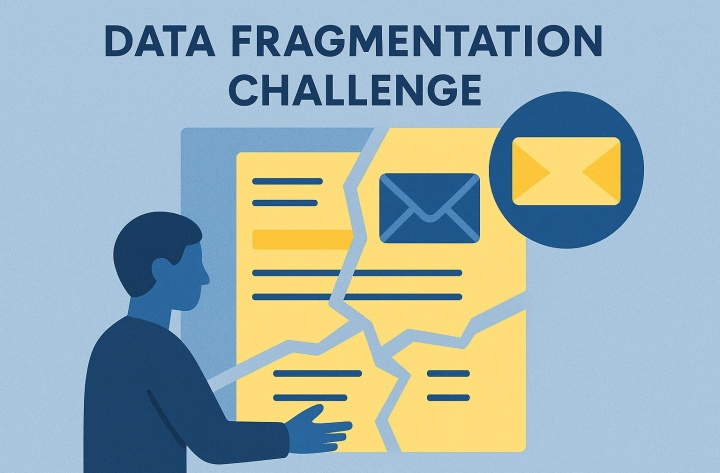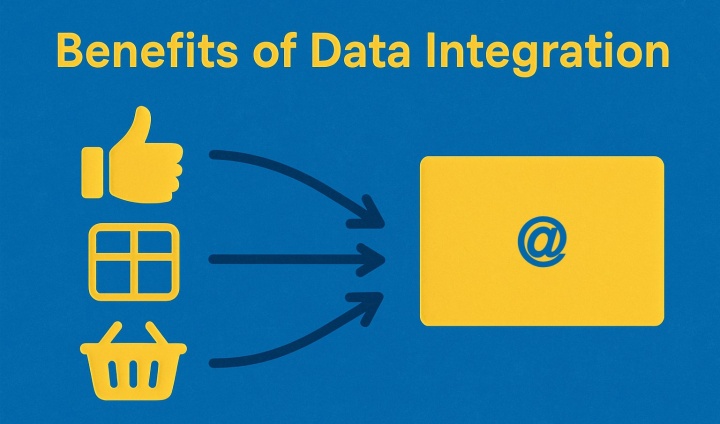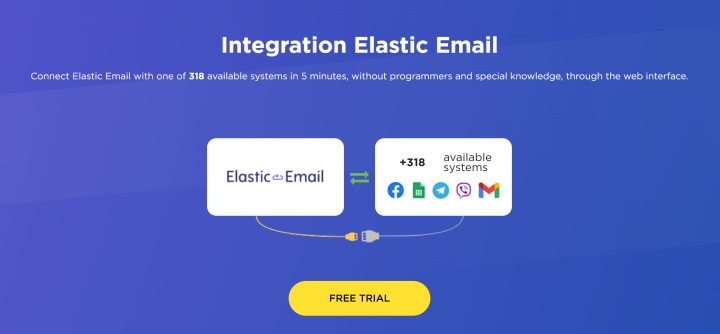The Power of Integrated Data: How Connecting Your Platforms Enhances Email Marketing Effectiveness
In today’s marketing world, “integrated data” refers to the seamless connection across various platforms within an organization. It also allows businesses to synchronize the information about their customers and create a unified view of them.
Consumers expect tailored experiences based on their behavior and preferences, so modern marketers face the challenge of delivering personalized, relevant, and timely email content to their audiences. This task becomes virtually impossible to do if their email marketing efforts are disconnected from other customer data. But, connecting email platforms with CRM systems, e-commerce platforms, website analytics, and social media, gives a comprehensive view of customer interactions and behaviors. Integrating data across platforms significantly enhances email marketing effectiveness by enabling personalization, automation, and deeper customer insights.
Data Fragmentation Challenge
Many organizations struggle with the challenge of fragmented data. Their customer information is scattered across multiple disconnected platforms like CRM, e-commerce, website analytics tools, and social media channels. Such fragmentation prevents marketing teams from realizing the full potential of their email efforts.

Here are the main obstacles that may appear when customer data is not integrated across the business platforms:
- Incomplete customer profiles – lack of a unified view of each customer’s journey, preferences, and history with the brand.
- Inefficient, manual data transfers – exporting and importing data manually between systems, often resulting in outdated information by the time it’s actually used.
- Missed marketing opportunities – inability to leverage data for targeted campaigns, or doing it too slowly, e.g., abandoned cart recovery emails.
- Limited personalization – generic and irrelevant emails, or basic personalization due to the lack of integrated customer data from multiple sources.
- Inaccurate reporting – selective email campaign metrics due to separated and incomplete data.
These challenges significantly block email marketing effectiveness and create disconnected customer experiences that fail to meet modern expectations for relevant and well-timed messages.
Key Platforms to Integrate With Email Marketing
To overcome data fragmentation challenges, it is crucial to integrate an email marketing platform with the below-mentioned key platforms.
CRM Systems
Customer Relationship Management (CRM) systems provide a central repository for customer information – contact details, interaction history, and purchase data. Integrating an email marketing platform with CRM enables:
- automatic synchronization of contact information and preferences;
- email campaigns triggered by specific CRM activities or status changes;
- tracking of email engagement directly in customer records;
- sales team visibility into marketing communications;
- enhanced lead scoring based on email behavior.
This integration results in the marketing and sales team working together with the same customer data, which creates a more consistent experience for the customer throughout their journey with the brand.
E-commerce Platforms
For online retailers, the connection between e-commerce and email marketing is particularly valuable. It offers insights into customer browsing behavior, purchase patterns, and abandoned carts.
Marketers can use integrated data to send emails with product recommendations based on browsing and purchase history. They can also send restock reminders based on customers' previous purchase dates. If a customer leaves products in their shopping cart, they can receive abandoned cart recovery emails with specific product information. Another way marketers may use integrated data is through post-purchase follow-ups and cross-sell recommendations. Last but not least, customer data from e-commerce platforms can be used to recognize VIP customers and send them special offers via email.
These integrations turn transactional data into personalized marketing opportunities that drive repeat purchases and increase customer lifetime value.
Website Analytics
The company’s website contains a wealth of behavioral data – website traffic, user behavior, and conversion rates. Using such information can dramatically improve email relevance.
Specific page visits or content downloads can trigger targeted emails. Website analytics gather data about what products or topics of interest are viewed by visitors. It can be then used to send personalized email content or re-engagement campaigns. People browsing patterns can be also useful in optimizing email send timing. Plus, website engagement metrics can help enhance audience segmentation. Last but not least, with website analytics and UTMs, you can measure revenue generated by your email campaigns.
When email marketing and website analytics work together, marketers can create campaigns that reflect individual customer interests demonstrated through browsing behavior.
Social Media
Social media platforms offer unique insights into customer preferences, engagement, and interests. Integrating email marketing and social media platforms can help create a consistent omnichannel experience while leveraging social insights to improve email relevance.
Social media and email marketing can complement each other when the same message is spread across these channels. Also, social content can be cross-promoted in email campaigns, and vice versa. Emails can promote specific social media content, but at the same time, social followers can be encouraged to sign up for the newsletter for special email treatment. Another advantage of integrating social media and email marketing platforms is that data obtained from social media channels about people’s interests and behaviors help improve customer profiles that can be used in email marketing campaigns.
Specific Benefits of Data Integration
Integrating email marketing with CRM, e-commerce, website analytics, or social media delivers tangible benefits.

Enhanced Personalization
When email platforms have access to comprehensive customer data, email personalization can go beyond basic name insertion and allow businesses to deliver truly contextual experiences:
- Dynamic content that reflects individual preferences, purchase history, and behavior.
- Personalized product recommendations based on browsing patterns and past purchases.
- Messaging that acknowledges the customer’s history with the brand.
- Contextual offers based on location, weather, or other relevant factors.
- Life cycle-specific content that matches where customers are in their journey.
Improved Segmentation and Targeting
Integrated data enables sophisticated segmentation strategies that were previously impossible. It can significantly improve campaign performance while reducing list fatigue and unsubscribe rates:
- Businesses can create multi-dimensional segments that combine demographic, behavioral, and transactional data.
- Segments are dynamic and update automatically as customer data changes.
- Activity data from multiple platforms can be used to create engagement-based segments.
- Opportunity-based segments can target specific upsell or cross-sell potential.
- Predictive segments can identify customers that are likely to convert or churn.
Automated Email Workflows
Data integration is the foundation for powerful marketing automation workflows. They can deliver the right message at the right time without manual intervention, scaling personalized communications efficiently:
- Specific customer actions across channels can trigger targeted emails.
- Nurture email sequences can be based on engagement levels and interests.
- Onboarding workflow can be tailored to specific customer types or acquisition sources.
- Inactivity patterns may trigger re-engagement campaigns.
- Email can be coordinated with other touchpoints to obtain cross-channel experience.
Deep Customer Insights
Integrated data provides valuable insights that can influence not just email marketing strategy but broader marketing and business decisions. Such information can help marketers continuously improve their strategies based on actual customer behavior rather than just assumptions:
- Marketers obtain a comprehensive understanding of the customer journey across touchpoints.
- They can identify high-value customer segments and behaviors.
- Integrated data helps recognize patterns and correlations between actions and outcomes.
- It gives a chance to early detect potential churn signals.
- There’s a clearer picture of customer preferences and interests.
More Accurate Performance Metrics
Data integration enables comprehensive measurement of email campaign effectiveness. This holistic approach provides a more accurate picture of email’s contribution to business results:
- A better understanding of revenue attribution across multiple touchpoints.
- Visibility into how email influences offline conversions.
- Long-term impact analysis on customer lifetime value.
- Comparative performance across channels in the customer journey.
- True ROI calculations incorporating data from multiple systems.
Step-by-Step Process for Auditing Current Systems and Creating an Integration Plan
Now, let’s move on to how to effectively integrate various platforms step by step.
1. Map Your Current App/Platform Ecosystem
Begin by documenting your current technology landscape. This mapping exercise creates visibility into your current state and highlights opportunities for integration.
- List all platforms that contain customer data.
- Identify what specific customer data resides in each system.
- Document the current flow of data between systems (both automated and manual).
- Note pain points and inefficiencies in the current setup.
- Identify key stakeholders who manage each platform.
2. Define Your Integration Goals
Establish clear objectives for your integration efforts. Clear goals ensure that your integration efforts focus on business outcomes rather than technical capabilities.
- Identify what integration would deliver the most business value.
- Define key performance indicators (KPIs) for measuring success.
- Prioritize integrations based on potential impact and complexity.
- Set realistic timeframes for implementation.
3. Assess Technical Requirements
Evaluate the technical aspects of your planned integrations. It will help you determine the feasibility and approach for each integration project.
- Research API capabilities and limitations of each platform.
- Determine if existing native integrations exist between your platforms.
- Assess whether Integration Platforms as a Service (iPaaS) would be beneficial.
- Identify potential data quality issues that need resolution.
- Evaluate internal technical resources versus the potential need for external support.
4. Develop an Integration Plan
Create a structured plan for implementation. A well-structured plan minimizes disruption and ensures successful implementation.
- Start with high-impact, low-complexity integrations for quick wins.
- Document data mapping between systems (which fields correspond across platforms).
- Establish data governance principles (ownership, quality standards, etc.)
- Create an implementation timeline divided into phases.
- Develop testing protocols to be able to validate integrations.
- Plan for training and change management.
5. Observe and Optimize the Results of the Integrations
After implementation, it’s time to continuously monitor and optimize your integrated systems. It will ensure you maximize the value of your integrated data ecosystem.
- Track KPIs to measure the impact of integrations on email performance.
- Gather feedback from marketing team members and other stakeholders.
- Address any data quality or synchronization issues.
- Identify opportunities for additional integration points.
- Regularly audit data flows to ensure optimal performance.
How to Integrate an Email Marketing Platform – Elastic Email – With Other Tools
ApiX-Drive offers robust capabilities for integrating Elastic Email, a powerful email marketing platform, with various marketing tools, creating a complex ecosystem that enhances email marketing effectiveness. You can choose from hundreds of available systems and integrate them with your Elastic Email account without the need to hire programmers or integrators.

To start, you need to select the online systems to be linked with Elastic Email. Then, you specify the actions between systems, for example, if you get new leads from Facebook, a contact is added to your Elastic Email account. The next step is to turn on the auto-update.
Here are some real-life examples of how Elastic Email can be integrated with CRM, e-commerce, website analytics, and social media platforms through ApiX-Drive.
CRM Integration (e.g., HubSpot, Salesforce)
Scenario: When a new contact is created in your CRM, a new contact is added to your Elastic Email contact list.
Trigger (CRM): “Get CONTACTS (new)” in HubSpot
Action (Elastic Email): “Add CONTACT to list”
E-commerce Integration (e.g., WooCommerce, PrestaShop)
Scenario: When a new order is placed, send a confirmation email via Elastic Email.
Trigger (e-commerce): “Get ORDERS (new)” in PrestaShop.
Action (Elastic Email): “Send transactional EMAIL.”
Website Integration (e.g., Contact Form 7)
Scenario: When a contact form is sent, a user is added to the list in Elastic Email.
Trigger: “Get DATA” in Contact Form 7.
Action (Elastic Email): “Add CONTACT to list.”
Additionally, “adding contact to the list” in Elastic Email, can trigger the entire automation sequence (for example: welcome sequence) and save you a lot of time.
Social Media Integration (e.g., Facebook)
Scenario: When a new lead is generated from Facebook, add them to an Elastic Email contact list.
Trigger (social media): Get LEADS (new) on Facebook.
Action (Elastic Email): “Add CONTACT to list.”
Conclusion
The integration of data across marketing platforms is no longer a luxury but a necessity for email marketing success. By connecting email marketing with CRM, e-commerce, website analytics, and social media platforms, marketers gain the comprehensive customer insights needed to deliver truly personalized, relevant, and timely communications.
The benefits of integrated data, like enhanced personalization, improved segmentation, automated workflows, deeper customer insights, and more accurate metrics, directly translate to improved campaign performance and stronger relationships with customers. While implementing an integrated approach requires careful planning and resource investment, the return in terms of marketing effectiveness and operational efficiency makes it well worth the effort.
By following the step-by-step process outlined in this article, marketers can transform their email programs from isolated campaigns to sophisticated, data-driven customer conversations that drive meaningful business results.

